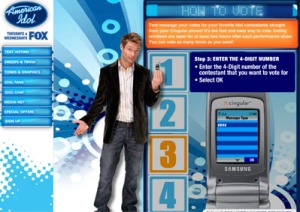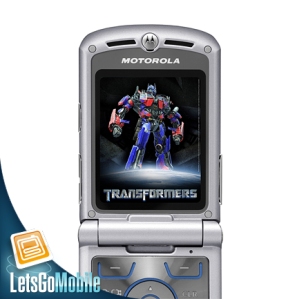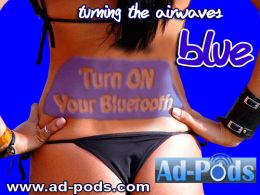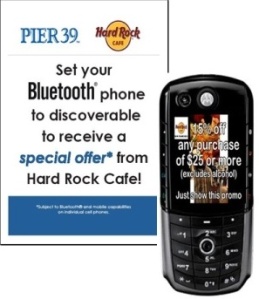A Whole New World
A few short weeks ago, I was asked to rank the effectiveness of new media in marketing. One of the least effective ways, I thought, was mobile marketing. Yes, it has the alliteration working for it, but I thought that was the end. However, in the time that has passed since, I have started to view mobile marketing in a much better light.
Mobile marketing is the first completely new marketing vehicles to hit the scene in over 50 years (Ramos, 2008). This information made me reconsider my thoughts about mobile marketing. I mean – if marketers are using it, it has to have some merit, right?
Well, yes. But before I delve into that, a little background information is necessary.
I’ve mentioned before that Generation Y is hard to reach, but it seems that is

Youngsters are using cell phones very early in life!
because marketers don’t know how to reach them. Teens have not just adopted new technology… they have internalized it (Montgomery, et al., 2004). For 78% of Gen Y, cell phones are the most popular methods of remote communication (Event Marketing Institute, 2008).
Cell phone usage even spans younger children. Approximately 35% of U.S. “tweens” (kids between the ages of 8 & 12), own a mobile phone. Five percent access the Internet on their phones each month, according to a December 2007 Neilsen Company study. Tweens are using their phones for more than just the Internet; The study also found that 20% of tweens have used text messaging, while 21% have used ringtones or ringback tones. Of the 5% of tweens who use their phones to access the Internet, 41% said they did so while commuting or traveling, while 56% did so at home. At home was also where the majority of tweens said they downloaded or watched TV on their phones (58%) or downloaded or played music on their phones (64%) (Neilsen Study, 2007).
With this information, it’s no wonder why marketers are embracing mobile marketing tactics. There are a variety of mobile marketing options.
M2M (Mobile to Mobile)

Part of American Idol's campaign
This is when marketers use mobile-based advertising to boost sales of mobile ring tones, wallpapers, games, and videos. Usually, it’s just part of a campaign, but could stand alone. It has an exceptionally high click-through-rate of over 50%.
One of the best examples of this is with American Idol and Cingular Wireless. Cingular customers had access to text chats with contestants, voting reminders, a fan club, trivia, and ring tones.
Mobile Games

Transformers Mobile Game
These are games that incorporate products as the stars of a game. Users download the games to their phones, often for fees of about $3.99 – $5.99 per game. Mobile games give marketers the opportunity to “blend the brand into entertainment experience, with rich graphics, color, and action,” described Craig Holland, former president of Thumbworks (a mobile game making company (Ramos, 2008).
BlueTooth Marketing

One Company Using BlueTooth Marketing
This is probably the newest form of mobile marketing. It uses BlueTooth technology to do tings like send advertisements or coupons. Because it’s still new, there are a lot of glitches that need to be worked out. However, it wasn’t too long ago that the same thing was said about websites. BlueTooth marketing isn’t limited to just cell phones, either. Messages can be sent to BlueTooth enabled laptops and PDA’s, too!
It’s truly impressive how innovative marketers are getting in terms of reaching the youngest generation. Since we’re (myself included) almost trained to tune out traditional media, it’s absolutely necessary to embrace new ways of marketing. Otherwise, a company runs the risk of being viewed as for adults only or not interested in our purchases.
Although not exactly mainstream now, mobile marketing will eventually be as much a part of our lives as radio advertisements and television commercials.
——-
Event Marketing Institute (2008 June 2). Event Marketing Institute Unveils New Findings on Marketing to Gen Y; New Study Highlights the Best Ways to Reach an Elusive Group That Spends More Time Texting Than Talking. Marketwire.com. Retrieved on December 15, 2008 from http://www.marketwire.com/press-release/Red-7-Media-863492.html
Montgomery, K., Gottlieb-Robles, B. and Larson, G. (2004 March). Youth as E-Citizens: Engaging the Digital Generation. Center for Social Media. Retrieved on December 15, 2008 from http://www.centerforsocialmedia.org/ecitizens/youthreport.pdf
Neilsen Study. (2007 December 03). Most Tweens Accessing TV, Music & Internet on their Phones, Do So at Home. PR NewsWire. Retrieved on December 15, 2008 from http://www.prnewswire.com/cgi-bin/stories.pl?ACCT=104&STORY=/www/story/12-03-2007/0004715443&EDATE=
Ramos, James. (2008 August 18). Lesson 5: Can You Hear Me Now? M2M, Advergaming, In-game Branding & RSS feeds. Retrieved on December 14, 2008 from https://ecampus.wvu.edu/webct/urw/lc5116001.tp0/cobaltMainFrame.dowebct
Marketing in the 21st Century
The first week of discussion helped me make the leap into the 21st century. I had to choose the most and least effective form of new media based on a list provided to me. When I saw this list, I had no clue how some of these new media could be used for marketing. To clarify, I’ll share the list.
1. Websites
2. Video ads
3. Widgets
4. RSS feeds
5. Podcasting
6. Banner ads
7. Short films
8. Blogs
9. Chat rooms
10. Blue tooth
11. In-game advertising
12. Social networking
My vote went to websites as the most effective new medium. My primary reason for choosing websites is that they are the most flexible media on the list. With websites, it is easy to include video ads, widgets, RSS feeds, podcasts, banner ads, short films, blogs, chat rooms, and social networking. Assigned reading from week one also supports this.
“When a consumer visits a websites, many cycles of messages can be exchanged in a short time. When the consumer visits some time later, the dialogue can resume just where it left off. The web medium is as subtle, as flexible, as pertinent, and as persuasive as one-on-one dialogue. It boasts a better memory than the most diligent salesperson and has none of the salesperson’s distaste for repetitive tasks. Although other media may be more gripping, the Web is uniquely responsive” (Deighton, 1996).
In order to choose a least effective medium, I had to do some research. I had no idea what a widget was or how podcasting or Bluetooth could be used as marketing tools. A widget has the potential to be a powerful marketing tool for a very niche audience. If companies can tie their products or services to something their target audience desires, a widget could be successful. For example, a good widget for Pampered Chef or Betty Crocker would provide users with different recipes featuring their products. This widget would encourage users to buy products from the widget’s brand and keep the brand name at the top of the user’s mind.
The most interesting new medium to me is BlueTooth. In the class discussion, I chose this at the least effective, primarily because it reminded me of telemarketing and has very little reach. However, as technology advances, BlueTooth has a great opportunity to be a very focused medium for companies to embrace. Right now, BlueTooth Proximity Marketing (BPM) is popular overseas in European locations.
Here’s how it works: a company sets up a “hot spot” where their target market will visit. The target market must have a BlueTooth enabled phone in “discoverable mode.” Then, the consumer will be able to receive messages for free over the BlueTooth connection.
An example of this could be a company like Nike setting up “hot spots” near tennis shoe retailers in the mall. Consumers receiving the BlueTooth marketing may receive a coupon on their phone for 10% off the next shoe purchase. The best way to think of BPM is as a virtual billboard or flyer advertisement. Right now, this technology is in its infancy stage, but there is a world of opportunity out there.
My Professor asked in the discussion if anyone had changed their minds from their original choices for most and least effective. Technically, I still feel that BlueTooth marketing needs to be further developed, but once it matures, I wouldn’t feel that it was the least effective. I still feel that websites are the most effective new media.
References:
Deighton, John. (November – December 1996). The Future of Interactive Marketing. Harvard Business Review.

